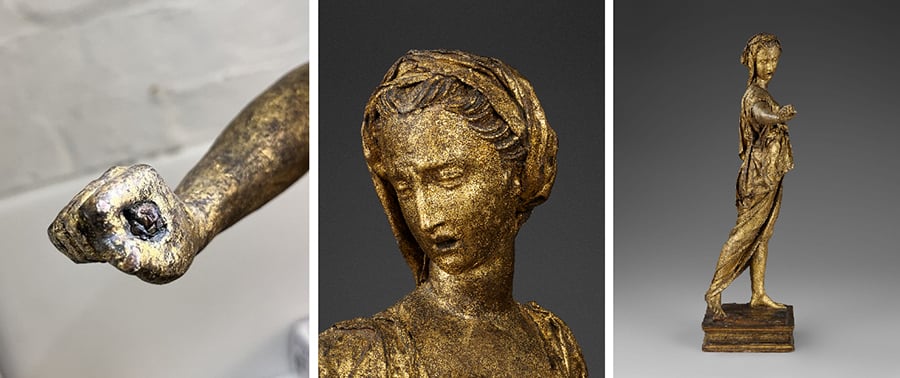Exploring Artistic Mastery
Examination and scientific study of a sculpture can yield fascinating insights into the artist’s methods and choices. The gilded wood statuette of Lucretia, crafted by Italian sculptor and architect Jacopo Sansovino around 1508 – 12, provides a unique glimpse into his creative process and the materials he favored.
A Historical Context
Upon its entry into the V&A collection in 1962, Lucretia was initially attributed to a French origin and received little attention until conservation efforts and analyses revived interest in the 1980s. Although Lucretia has been linked to Sansovino for several decades, it was only recently that scholarly arguments, supported by figures like Lorenzo Principi and curator Bruce Boucher, have solidified this attribution.
The PhD Placement Experience
During a PhD placement at the V&A, a comprehensive study of Lucretia was conducted, which involved reviewing conservation reports and scientific evaluations. This analysis attests to Sansovino’s meticulous attention to detail and his inclination to push the boundaries of materials through innovative experimentation.
Unveiling Lucretia’s Dramatic Moment
Lucretia, depicted before the tragic act of taking her own life with a dagger, captures a moment frozen in time. Although the blade is missing, her right hand clutches remnants of the hilt, with her arm outstretched, furrowed brows, and lips parted. This vivid portrayal of tension invites viewers into the story.
Gilded Works and Their Significance
Other known small-scale gilded works by Sansovino include the Descent from the Cross and the Virgin and Child, contributing to the dialogue of artistry among Italian painters. While Lucretia may have also served as a model, its specific references remain unidentified.
Material Choices and Techniques
Craftsmanship and Detail
Material analyses conducted by conservation scientist Jo Darrah in 1982 validated that both the base and body of Lucretia were carved from a single piece of poplar wood. The robe and head covering consist of linen dipped in glue, significantly differing from the entirely wax figures of the Virgin and Child, and the mixed media of the Descent from the Cross.
Intricate Drapery
The lightweight nature of the glue used for Lucretia’s robe permits grand folds to take form. At first glance, her attire appears to hang carelessly, but a closer examination reveals purposeful draping tailored to the intense narrative. The linen accentuates her legs, especially at the left thigh, enhancing the sense of movement and tension as she prepares to act.
Refining the Pose
Modifications to Lucretia’s wooden body display the sculpture’s exploratory character. Sansovino adjusted her arm positioning, head tilt, and neck angle to amplify the drama of her posture. Insights from research indicate that her gaze directs attention to the dagger, emphasizing the intended narrative.
Attention to Detail
Sansovino’s precision shines in Lucretia’s left hand, curled around her robe with a small but substantial gesture—pulling back the fabric to reveal her heart. Close inspection identified what appears to be a previously broken finger, now reattached to enhance this gesture’s realism, further underlining the thoughtful craftsmanship of the artist.
Engaging with Lucretia
The intricacies of Lucretia suggest that smaller-scale works were an invitation for Sansovino to discover and refine his methods. Questions surrounding the creation of Lucretia further emphasize the value of thorough visual analysis: Was this work merely an artistic experiment? What other materials did Sansovino engage with? How were his techniques mirrored or replicated in other sculptures?
The Continuing Journey of Discovery
As research unfolds, the layers of meaning and artistry surrounding Lucretia deepen, promising further revelations on Sansovino’s evolving methodology.
Drawing Connections to Tourism
Exploring the artistic legacy of figures like Jacopo Sansovino adds to the enriching experience of cultural tourism. Visitors to museums often seek not just visuals, but stories and insights into the creative processes that shape the artworks they encounter. This discovery process enhances travel experiences, allowing tourists to genuinely connect with art narratives.
In conclusion, while reviews and insights can shed light, they are no substitute for personal. On GetExperience, booking experiences from verified providers at fair prices enables informed decisions that minimize unnecessary costs or disappointments. With an array of options such as museum tours with live guides or exclusive yacht charters for events, GetExperience stands out in providing the convenience, affordability, and breadth of experience choices needed to explore cultural treasures fully. GetExperience.com
Ultimately, uncovering the story behind Jacopo Sansovino’s Lucretia enhances the appreciation of not just his work, but also the broader artistic legacy that invites us to explore adventure activities and cultural programs available worldwide.

